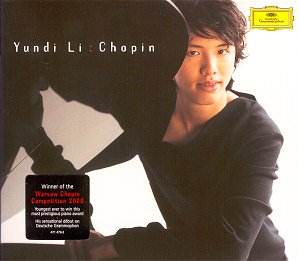Yundi Li looks like a twit. Some record company executive
has obviously marched him into their study and told him to GET TRENDY,
but the fashion shoot that accompanies this disc is preposterous. Included
in The Look are a ridiculous pair of flares, a suit white enough for
an FA Cup Final, and the same gormless stare that Ronaldo has when he
models clothes. Given the hagiography that takes the place of sleeve
notes, DG are obviously looking for major artist build, and are sparing
no promotional effort.
But I forgive him because he is a genius. Winner, at
19, of the last Warsaw Chopin Competition, the boy can obviously play
a bit. He is building on that success by debuting with an all-Chopin
recital that reveals an excellent technique and a beautiful touch. Apparently
an admirer of Zimmerman, Yundi Li certainly achieves that great pianist’s
thoughtful clarity and attention to detail, albeit at slightly less
tardy tempos. From the opening arpeggiated chord of the Third Sonata,
which forms the meat of this recital disc, his approach to the Chopin
soundworld is apparent: clean – no wash of pedal here thank you very
much – and constantly forward moving. It is a powerful performance that
marks Yundi Li as a player of real technique and talent.
All this is very well, but is there a musical personality
at work here? The answer I think is a qualified yes. The most obvious
place to measure this is the ubiquitous B flat minor nocturne, by far
the most famous piece included in this recital and one that has had
the attention of all the great pianists. Compared to, say, the magnificent
and deeply felt version by Maria João Pires, Yundi Li may seem
to lack a little poetry. Everything is technically perfect – rubato,
dynamics and important modulations all delicately executed – and the
initial impression is one of dryness (anyone used to the effusive Barenboim
version would certainly think so). But why should Chopin come with a
box of hankies? Like the Boulez Ring, this is a style that strips
away the self-indulgent love of a sound in favour of a clarity that
reveals other, equally interesting harmonic details. This analysis I
think applies to the disc as a whole. There is a little way to go –
there is certainly room for more poetry – but it is a path worth pursuing
and this disc can be given a qualified welcome as the first step along
it.
Aidan Twomey


